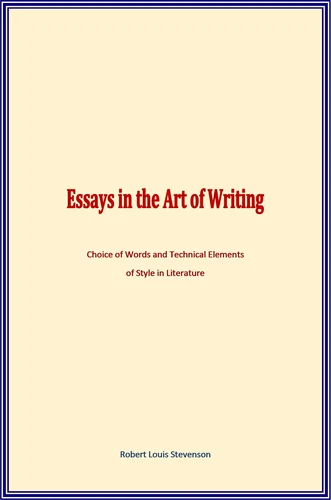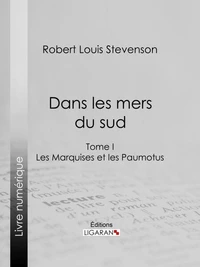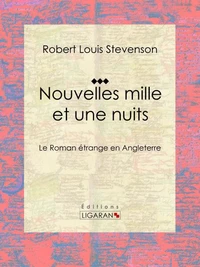Essays in the Art of Writing. Choice of Words and Technical Elements of Style in Literature
Par :Formats :
Disponible dans votre compte client Decitre ou Furet du Nord dès validation de votre commande. Le format Multi-format est :
- Pour les liseuses autres que Vivlio, vous devez utiliser le logiciel Adobe Digital Edition. Non compatible avec la lecture sur les liseuses Kindle, Remarkable et Sony
 , qui est-ce ?
, qui est-ce ?Notre partenaire de plateforme de lecture numérique où vous retrouverez l'ensemble de vos ebooks gratuitement
Pour en savoir plus sur nos ebooks, consultez notre aide en ligne ici
- FormatMulti-format
- ISBN978-2-36659-740-0
- EAN9782366597400
- Date de parution08/08/2019
- Protection num.NC
- Infos supplémentairesMulti-format incluant ePub avec ...
- ÉditeurEditions Le Mono
Résumé
There is nothing more disenchanting to man than to be shown the springs and mechanism of any art...
The art of literature stands apart from among its sisters, because the material in which the literary artist works is the dialect of life; hence, on the one hand, a strange freshness and immediacy of address to the public mind, which is ready prepared to understand it; but hence, on the other, a singular limitation.
The sister arts enjoy the use of a plastic and ductile material, like the modeller's clay; literature alone is condemned to work in mosaic with finite and quite rigid words. You have seen these blocks, dear to the nursery: this one a pillar, that a pediment, a third a window or a vase. It is with blocks of just such arbitrary size and figure that the literary architect is condemned to design the palace of his art.
Nor is this all; for since these blocks, or words, are the acknowledged currency of our daily affairs, there are here possible none of those suppressions by which other arts obtain relief, continuity, and vigour: no hieroglyphic touch, no smoothed impasto, no inscrutable shadow, as in painting; no blank wall, as in architecture; but every word, phrase, sentence, and paragraph must move in a logical progression, and convey a definite conventional import.
The first merit which attracts in the pages of a good writer, or the talk of a brilliant conversationalist, is the apt choice and contrast of the words employed. It is, indeed, a strange art to take these blocks, rudely conceived for the purpose of the market or the bar, and by tact of application touch them to the finest meanings and distinctions, restore to them their primal energy, wittily shift them to another issue, or make of them a drum to rouse the passions.
But though this form of merit is without doubt the most sensible and seizing, it is far from being equally present in all writers...
The sister arts enjoy the use of a plastic and ductile material, like the modeller's clay; literature alone is condemned to work in mosaic with finite and quite rigid words. You have seen these blocks, dear to the nursery: this one a pillar, that a pediment, a third a window or a vase. It is with blocks of just such arbitrary size and figure that the literary architect is condemned to design the palace of his art.
Nor is this all; for since these blocks, or words, are the acknowledged currency of our daily affairs, there are here possible none of those suppressions by which other arts obtain relief, continuity, and vigour: no hieroglyphic touch, no smoothed impasto, no inscrutable shadow, as in painting; no blank wall, as in architecture; but every word, phrase, sentence, and paragraph must move in a logical progression, and convey a definite conventional import.
The first merit which attracts in the pages of a good writer, or the talk of a brilliant conversationalist, is the apt choice and contrast of the words employed. It is, indeed, a strange art to take these blocks, rudely conceived for the purpose of the market or the bar, and by tact of application touch them to the finest meanings and distinctions, restore to them their primal energy, wittily shift them to another issue, or make of them a drum to rouse the passions.
But though this form of merit is without doubt the most sensible and seizing, it is far from being equally present in all writers...
There is nothing more disenchanting to man than to be shown the springs and mechanism of any art...
The art of literature stands apart from among its sisters, because the material in which the literary artist works is the dialect of life; hence, on the one hand, a strange freshness and immediacy of address to the public mind, which is ready prepared to understand it; but hence, on the other, a singular limitation.
The sister arts enjoy the use of a plastic and ductile material, like the modeller's clay; literature alone is condemned to work in mosaic with finite and quite rigid words. You have seen these blocks, dear to the nursery: this one a pillar, that a pediment, a third a window or a vase. It is with blocks of just such arbitrary size and figure that the literary architect is condemned to design the palace of his art.
Nor is this all; for since these blocks, or words, are the acknowledged currency of our daily affairs, there are here possible none of those suppressions by which other arts obtain relief, continuity, and vigour: no hieroglyphic touch, no smoothed impasto, no inscrutable shadow, as in painting; no blank wall, as in architecture; but every word, phrase, sentence, and paragraph must move in a logical progression, and convey a definite conventional import.
The first merit which attracts in the pages of a good writer, or the talk of a brilliant conversationalist, is the apt choice and contrast of the words employed. It is, indeed, a strange art to take these blocks, rudely conceived for the purpose of the market or the bar, and by tact of application touch them to the finest meanings and distinctions, restore to them their primal energy, wittily shift them to another issue, or make of them a drum to rouse the passions.
But though this form of merit is without doubt the most sensible and seizing, it is far from being equally present in all writers...
The sister arts enjoy the use of a plastic and ductile material, like the modeller's clay; literature alone is condemned to work in mosaic with finite and quite rigid words. You have seen these blocks, dear to the nursery: this one a pillar, that a pediment, a third a window or a vase. It is with blocks of just such arbitrary size and figure that the literary architect is condemned to design the palace of his art.
Nor is this all; for since these blocks, or words, are the acknowledged currency of our daily affairs, there are here possible none of those suppressions by which other arts obtain relief, continuity, and vigour: no hieroglyphic touch, no smoothed impasto, no inscrutable shadow, as in painting; no blank wall, as in architecture; but every word, phrase, sentence, and paragraph must move in a logical progression, and convey a definite conventional import.
The first merit which attracts in the pages of a good writer, or the talk of a brilliant conversationalist, is the apt choice and contrast of the words employed. It is, indeed, a strange art to take these blocks, rudely conceived for the purpose of the market or the bar, and by tact of application touch them to the finest meanings and distinctions, restore to them their primal energy, wittily shift them to another issue, or make of them a drum to rouse the passions.
But though this form of merit is without doubt the most sensible and seizing, it is far from being equally present in all writers...





















